
This selection of images featured in the Library's 2007–08 exhibition, Victorians on vacation. View images of Victorians in their element, exploring diverse landscapes far and wide, and upholding the long-held tradition of the 'Aussie' holiday.

This selection of images featured in the Library's 2007–08 exhibition, Victorians on vacation. View images of Victorians in their element, exploring diverse landscapes far and wide, and upholding the long-held tradition of the 'Aussie' holiday.

Dacre Stubbs, digital print from an original colour transparency, 1967. Gift of Mr Martin Stubbs, 2005.
Dacre Stubbs worked as a photographer for the BBC before being commissioned by the Australian Department of Information to document the migrant journey to Australia. In 1948, he and his wife, Pauline, settled in Melbourne, where they opened a successful photographic studio under Pauline’s management. Her interest in Australian Indigenous history led to working holidays in northern Australia, which were documented for Walkabout magazine in articles written by Pauline with photographs by Dacre. The couple’s interest in Indigenous art culminated in the publication of Prehistoric art of Australia in 1974. In the 1960s, the Stubbs retired to establish the Lulgra Winery near Lakes Entrance.

Dacre Stubbs, digital print from an original colour transparency, 1967. Gift of Mr Martin Stubbs, 2005.
Dacre Stubbs worked as a photographer for the BBC before being commissioned by the Australian Department of Information to document the migrant journey to Australia. In 1948, he and his wife, Pauline, settled in Melbourne, where they opened a successful photographic studio under Pauline’s management. Her interest in Australian Indigenous history led to working holidays in northern Australia, which were documented for Walkabout magazine in articles written by Pauline with photographs by Dacre. The couple’s interest in Indigenous art culminated in the publication of Prehistoric art of Australia in 1974. In the 1960s, the Stubbs retired to establish the Lulgra Winery near Lakes Entrance.

Alice Manfield [‘Guide Alice’] (1878-1960), c1925-35. Flexible base negative. Gift of Ms Anne Shannon, 2003.
Alice Manfield was born into a family of tourism pioneers who had run a chalet on the slopes of Mt Buffalo since the 1850s. A keen amateur photographer and naturalist, ‘Guide Alice’ divided her time between conducting alpine tours, writing on the local flora and fauna and serving behind the bar at her mother’s Temperance Hotel, famous for beer so good that it was suspected of being alcoholic. Alice caused a stir with her mountaineering trousersuit. From 1912 to 1927 she ran her own guesthouse, catering for the likes of Percy Grainger and Sir John Monash, with whom she maintained lively correspondence. In the evenings, guests were regaled with lantern slide presentations, covering everything from Guide Alice’s tours to her lyrebird studies.

Alice Manfield [‘Guide Alice’] (1878-1960), c1925-35. Flexible base negative. Gift of Ms Anne Shannon, 2003.
Alice Manfield was born into a family of tourism pioneers who had run a chalet on the slopes of Mt Buffalo since the 1850s. A keen amateur photographer and naturalist, ‘Guide Alice’ divided her time between conducting alpine tours, writing on the local flora and fauna and serving behind the bar at her mother’s Temperance Hotel, famous for beer so good that it was suspected of being alcoholic. Alice caused a stir with her mountaineering trousersuit. From 1912 to 1927 she ran her own guesthouse, catering for the likes of Percy Grainger and Sir John Monash, with whom she maintained lively correspondence. In the evenings, guests were regaled with lantern slide presentations, covering everything from Guide Alice’s tours to her lyrebird studies.
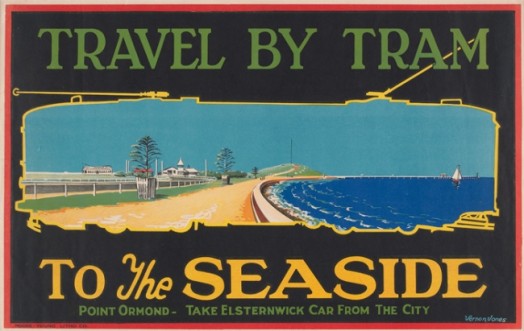
Vernon Jones (1908-2002), c1927, colour lithograph. Gift of Mr Peter Jones, 2007.
By the 1890s cable trams crisscrossed suburban Melbourne and carried day-trippers and holiday-makers to South Melbourne and St Kilda. In 1906, the Victorian Railways built the city’s first electric tramway, which ran from St Kilda to Brighton. This poster may have been created to promote the scenic route taken by the Prahran and Malvern Tramways Trust line, which was extended to Point Ormond in 1915. It was designed by Vernon Jones, a painter, sculptor and commercial artist. Jones had studied under the painters Bernard Hall and WB McInnes, as well as the master engravers Prebble & James. Dioramas and war paintings by Jones are held by the Australian War Memorial.
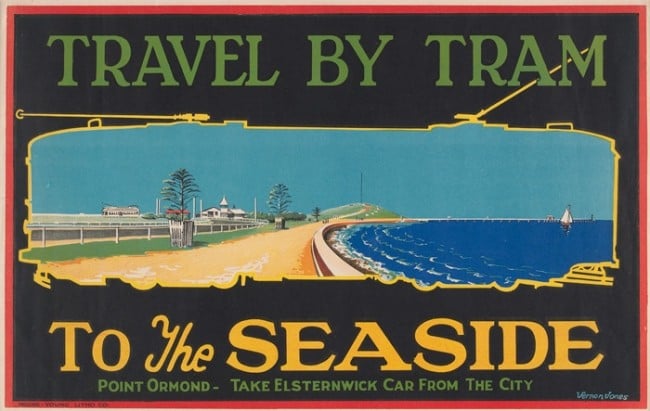
Vernon Jones (1908-2002), c1927, colour lithograph. Gift of Mr Peter Jones, 2007.
By the 1890s cable trams crisscrossed suburban Melbourne and carried day-trippers and holiday-makers to South Melbourne and St Kilda. In 1906, the Victorian Railways built the city’s first electric tramway, which ran from St Kilda to Brighton. This poster may have been created to promote the scenic route taken by the Prahran and Malvern Tramways Trust line, which was extended to Point Ormond in 1915. It was designed by Vernon Jones, a painter, sculptor and commercial artist. Jones had studied under the painters Bernard Hall and WB McInnes, as well as the master engravers Prebble & James. Dioramas and war paintings by Jones are held by the Australian War Memorial.

Bright Progress Committee and Alpine Club, 1897.

Bright Progress Committee and Alpine Club, 1897.

HW Davis, editor, 1891.
Likening Warrnambool’s climate to that of Nice, this early guide for tourists extols the virtues of the Victorian port as a ‘paradise of peace and plenty’. Readers were directed to take refreshments at a coffee palace before retiring to one of the town’s family hotels. From there they could hire a horse-drawn carriage to view the picturesque sights of coast and country, or experience the curative powers of the sea baths. Warrnambool was only six hours from Melbourne by rail and a first-class return ticket could be had for £2. Alternatively, holidaymakers could make the 16-hour trip by steamer for a mere 10 shillings.

HW Davis, editor, 1891.
Likening Warrnambool’s climate to that of Nice, this early guide for tourists extols the virtues of the Victorian port as a ‘paradise of peace and plenty’. Readers were directed to take refreshments at a coffee palace before retiring to one of the town’s family hotels. From there they could hire a horse-drawn carriage to view the picturesque sights of coast and country, or experience the curative powers of the sea baths. Warrnambool was only six hours from Melbourne by rail and a first-class return ticket could be had for £2. Alternatively, holidaymakers could make the 16-hour trip by steamer for a mere 10 shillings.

James Northfield (1887-1973), c1931. Colour lithograph. Gift of Mr Charles Weetman, 1989. Courtesy of the James Northfield Heritage Art Trust ©.
James Northfield was one of the key commercial artists working during the ‘golden age’ of Australian poster design in the 1930s. Born in Geelong, he trained as a lithographic artist with the Melbourne printing firm of FW Niven. James Northfield produced a number of versions of this poster. This one, in Dutch, reflects the great popularity of the Victorian ski fields among the Dutch expatriate population in Indonesia. It promotes the area as being ‘only 12 days from Java’, an indication of the time it took to travel in the early 20th century.
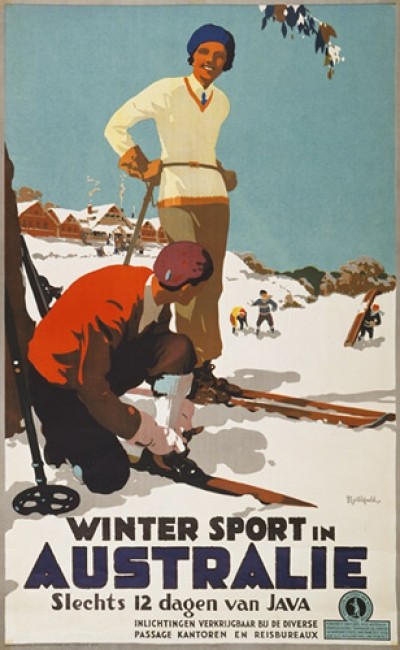
James Northfield (1887-1973), c1931. Colour lithograph. Gift of Mr Charles Weetman, 1989. Courtesy of the James Northfield Heritage Art Trust ©.
James Northfield was one of the key commercial artists working during the ‘golden age’ of Australian poster design in the 1930s. Born in Geelong, he trained as a lithographic artist with the Melbourne printing firm of FW Niven. James Northfield produced a number of versions of this poster. This one, in Dutch, reflects the great popularity of the Victorian ski fields among the Dutch expatriate population in Indonesia. It promotes the area as being ‘only 12 days from Java’, an indication of the time it took to travel in the early 20th century.

Alexander Goodall (1874-1901), 1897. Gift of Mrs J Milne, 1985.
Alexander Goodall’s richly illustrated diaries, kept from the age of 17, provide an entertaining window into a young man’s recreational life in the 1890s. Born in Mortlake, Goodall left school at 14 and worked as a clerk with the Post and Telegraph Office. Suffering from weak lungs, he moved to warmer Rochester and later to Geelong and Bendigo. Cycling was all the rage in the 1890s and it became a pleasurable way for Goodall to enjoy the benefits of fresh air and exercise. He often rode long distances, travelling more than 6000 kilometres in his first 12 months of owning a bicycle.

Alexander Goodall (1874-1901), 1897. Gift of Mrs J Milne, 1985.
Alexander Goodall’s richly illustrated diaries, kept from the age of 17, provide an entertaining window into a young man’s recreational life in the 1890s. Born in Mortlake, Goodall left school at 14 and worked as a clerk with the Post and Telegraph Office. Suffering from weak lungs, he moved to warmer Rochester and later to Geelong and Bendigo. Cycling was all the rage in the 1890s and it became a pleasurable way for Goodall to enjoy the benefits of fresh air and exercise. He often rode long distances, travelling more than 6000 kilometres in his first 12 months of owning a bicycle.

JW Lindt (1845-1926), c1880–94. Albumen silver photograph.
JW (John William) Lindt arrived in Australia from Germany at age 17. He soon became an assistant in a photography studio in Grafton, where he produced his well-known series of staged portraits of Indigenous people from the area. In 1876 he moved to Melbourne and opened a prestigious studio where he specialised in portraits and landscape views. Lorne was a popular tourist destination at that time. Its appeal lay in the combination of rugged coastline, fern gullies and rivers.
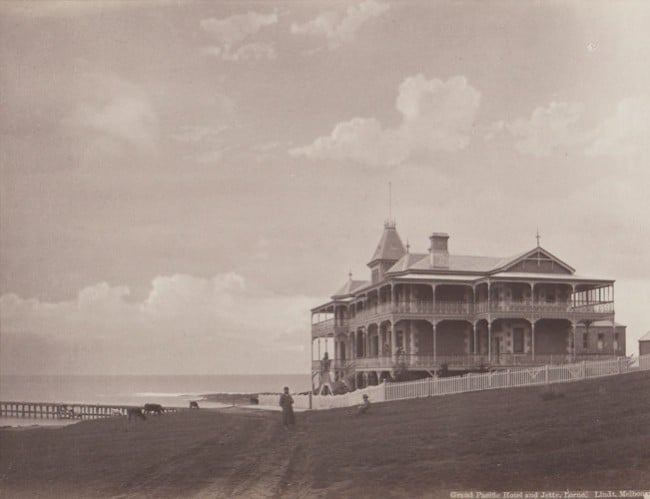
JW Lindt (1845-1926), c1880–94. Albumen silver photograph.
JW (John William) Lindt arrived in Australia from Germany at age 17. He soon became an assistant in a photography studio in Grafton, where he produced his well-known series of staged portraits of Indigenous people from the area. In 1876 he moved to Melbourne and opened a prestigious studio where he specialised in portraits and landscape views. Lorne was a popular tourist destination at that time. Its appeal lay in the combination of rugged coastline, fern gullies and rivers.

Warren Kirk (1951-), c1993. Cibachrome photograph, printed 1998.
During the late 1980s and early 1990s photographer Warren Kirk set out to document the buildings that were beginning to vanish from Victorian streets. His Disappearing Victoria series is a unique visual record of aspects of daily life being lost as a result of either redevelopment or decay. For Kirk, every photograph is a piece of history and these images of milk bars and hairdressers, motels and draperies, capture moments in time in the changing face of Victoria.

Warren Kirk (1951-), c1993. Cibachrome photograph, printed 1998.
During the late 1980s and early 1990s photographer Warren Kirk set out to document the buildings that were beginning to vanish from Victorian streets. His Disappearing Victoria series is a unique visual record of aspects of daily life being lost as a result of either redevelopment or decay. For Kirk, every photograph is a piece of history and these images of milk bars and hairdressers, motels and draperies, capture moments in time in the changing face of Victoria.

James Northfield (1887-1973), c1930–39. Colour lithograph. Courtesy of the James Northfield Heritage Art Trust ©.
In the 1880s, visiting author Mark Twain compared traffic on the ‘Mighty Murray’ with that of his beloved Mississippi. The mild Mediterranean-like winters made the towns along the river particularly attractive to tourists. By the 1890s, paddle-steamer companies were promoting day trips and holiday transfers in association with the Victorian Railways. The 36-hour trip from Melbourne to Mildura took passengers by train to Echuca, where they boarded a paddle-steamer. By the turn of the century some steamship companies on the Murray were offering passengers a cosy cabin, a hot bath and five square meals a day. This poster is one in a series produced by the Victorian Railways in the 1930s to compete with the growing popularity of coach transfers.

James Northfield (1887-1973), c1930–39. Colour lithograph. Courtesy of the James Northfield Heritage Art Trust ©.
In the 1880s, visiting author Mark Twain compared traffic on the ‘Mighty Murray’ with that of his beloved Mississippi. The mild Mediterranean-like winters made the towns along the river particularly attractive to tourists. By the 1890s, paddle-steamer companies were promoting day trips and holiday transfers in association with the Victorian Railways. The 36-hour trip from Melbourne to Mildura took passengers by train to Echuca, where they boarded a paddle-steamer. By the turn of the century some steamship companies on the Murray were offering passengers a cosy cabin, a hot bath and five square meals a day. This poster is one in a series produced by the Victorian Railways in the 1930s to compete with the growing popularity of coach transfers.

Gert Sellheim (1901-1970), c1930, colour lithograph. © Nik Sellheim, courtesy Josef Lebovic Gallery.
Estonian-born architect and graphic designer Gert Sellheim studied in Germany and migrated to Australia in 1926. He established a practice in Melbourne in 1930. Sellheim was one of the first artists in Australia to experiment with abstraction and modern European art styles in the production of travel posters. In 1939, he won the Sulman Prize for his interior design of the Victorian Government Tourist Bureau.
In the 1930s, Gert Sellheim’s bright and striking designs were commissioned by the Victorian Railways and the Australian National Travel Association. In 1947, he moved to Sydney to pursue his graphic design work, and it was there he created his most recognised work, the flying kangaroo logo for Qantas.

Gert Sellheim (1901-1970), c1930, colour lithograph. © Nik Sellheim, courtesy Josef Lebovic Gallery.
Estonian-born architect and graphic designer Gert Sellheim studied in Germany and migrated to Australia in 1926. He established a practice in Melbourne in 1930. Sellheim was one of the first artists in Australia to experiment with abstraction and modern European art styles in the production of travel posters. In 1939, he won the Sulman Prize for his interior design of the Victorian Government Tourist Bureau.
In the 1930s, Gert Sellheim’s bright and striking designs were commissioned by the Victorian Railways and the Australian National Travel Association. In 1947, he moved to Sydney to pursue his graphic design work, and it was there he created his most recognised work, the flying kangaroo logo for Qantas.

Harold Freedman (1915-1999), c1952, colour lithograph. Gift of Mr Harold Freedman, 1990.
Harold Freedman was a painter, illustrator and commercial artist. After serving as a war artist in Borneo, he established the Melbourne Print Group at RMIT in 1951. Freedman’s early study with Napier Waller led to his interest in large-scale mural work. The 'Cavalcade of Transport' mural, commissioned for the Spencer Street Station foyer in 1973, is perhaps his best-known work. It was removed during redevelopment works and returned to the newly named Southern Cross Station in 2006. Freedman also created murals for the Melbourne Airport, the Australian War Memorial and Flemington Racecourse. He was appointed state artist for Victoria in 1972, a position he held until 1983.
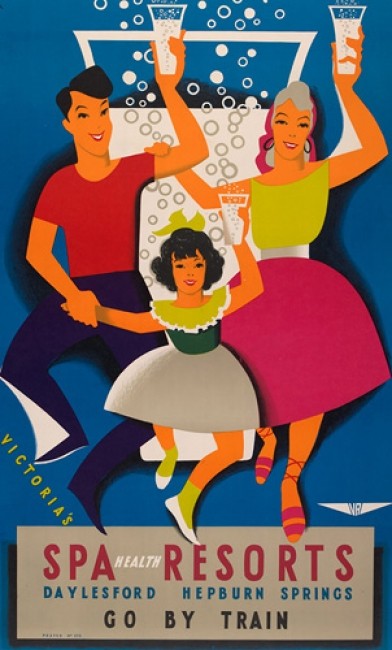
Harold Freedman (1915-1999), c1952, colour lithograph. Gift of Mr Harold Freedman, 1990.
Harold Freedman was a painter, illustrator and commercial artist. After serving as a war artist in Borneo, he established the Melbourne Print Group at RMIT in 1951. Freedman’s early study with Napier Waller led to his interest in large-scale mural work. The 'Cavalcade of Transport' mural, commissioned for the Spencer Street Station foyer in 1973, is perhaps his best-known work. It was removed during redevelopment works and returned to the newly named Southern Cross Station in 2006. Freedman also created murals for the Melbourne Airport, the Australian War Memorial and Flemington Racecourse. He was appointed state artist for Victoria in 1972, a position he held until 1983.

Unknown, c1930, gelatin silver photograph.

Unknown, c1930, gelatin silver photograph.
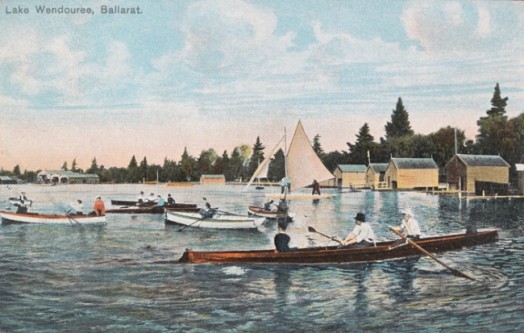
Unknown, c1908, colour postcard.
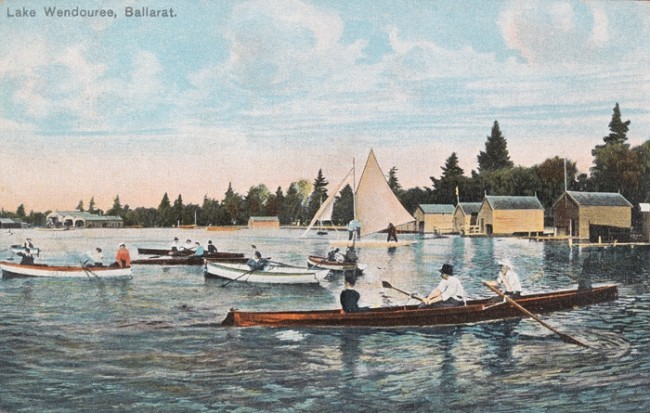
Unknown, c1908, colour postcard.

Artcolour Transfer Co, c1955, colour postcard.

Artcolour Transfer Co, c1955, colour postcard.

Victorian Railways photographer, 1954, flexible base negative.

Victorian Railways photographer, 1954, flexible base negative.

Victorian Railways photographer, c1945–56, flexible base negative.

Victorian Railways photographer, c1945–56, flexible base negative.

Victorian Railways photographer, c1945–56, flexible base negative.

Victorian Railways photographer, c1945–56, flexible base negative.

Gustav Damman, c1895–1917, glass negative. Gift of Mr Stan Damman, 1994.
In 1853, newly arrived migrant Freeman Cobb (1830–78) and three fellow Americans launched the Cobb & Co delivery service from Melbourne to Port Melbourne. The following year heralded the arrival of the company’s first passenger service, which ran six days a week between Castlemaine, Bendigo and Melbourne. Budget-minded passengers purchased the cheapest seats, which were inside the dusty carriage. Under the management of another American, James Rutherford, Cobb & Co became the pre-eminent passenger service in the country, extending its reach across the state and into New South Wales and Queensland. The last Cobb & Co coach made its final trip on 14 August 1924.

Gustav Damman, c1895–1917, glass negative. Gift of Mr Stan Damman, 1994.
In 1853, newly arrived migrant Freeman Cobb (1830–78) and three fellow Americans launched the Cobb & Co delivery service from Melbourne to Port Melbourne. The following year heralded the arrival of the company’s first passenger service, which ran six days a week between Castlemaine, Bendigo and Melbourne. Budget-minded passengers purchased the cheapest seats, which were inside the dusty carriage. Under the management of another American, James Rutherford, Cobb & Co became the pre-eminent passenger service in the country, extending its reach across the state and into New South Wales and Queensland. The last Cobb & Co coach made its final trip on 14 August 1924.
Unknown, c1900–30, colour postcard.
Unknown, c1900–30, colour postcard.

Matthew Sleeth, 2004, type C photographs, printed 2006.
Matthew Sleeth blurs the lines between art and documentary photography. He is drawn to both the foreign and the familiar, finding elements of each in the other. With his 'Rosebud' series he finds darkness as well as light in the annual summer holiday at the beach. Sleeth had holidayed annually at Rosebud as a child in the 1970s, and he captures the timeless nature of camping on the foreshore, card games by gas light, Christmas dinner in the annexe and teenage mating rituals. But the nostalgia and happy memories are infused with a sense of boredom and menace, an underbelly that most holiday snapshots tend to avoid.

Matthew Sleeth, 2004, type C photographs, printed 2006.
Matthew Sleeth blurs the lines between art and documentary photography. He is drawn to both the foreign and the familiar, finding elements of each in the other. With his 'Rosebud' series he finds darkness as well as light in the annual summer holiday at the beach. Sleeth had holidayed annually at Rosebud as a child in the 1970s, and he captures the timeless nature of camping on the foreshore, card games by gas light, Christmas dinner in the annexe and teenage mating rituals. But the nostalgia and happy memories are infused with a sense of boredom and menace, an underbelly that most holiday snapshots tend to avoid.